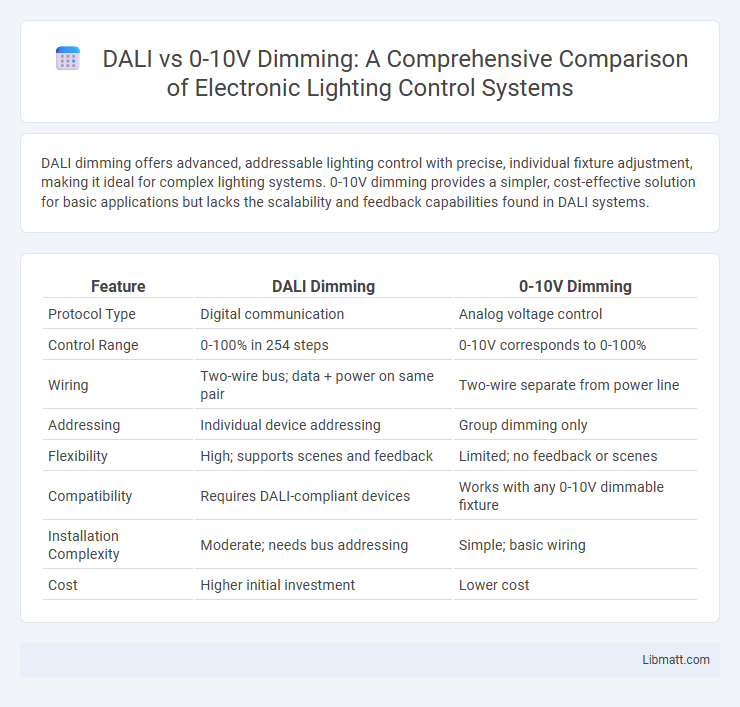DALI dimming offers advanced, addressable lighting control with precise, individual fixture adjustment, making it ideal for complex lighting systems. 0-10V dimming provides a simpler, cost-effective solution for basic applications but lacks the scalability and feedback capabilities found in DALI systems.
Table of Comparison
| Feature | DALI Dimming | 0-10V Dimming |
|---|---|---|
| Protocol Type | Digital communication | Analog voltage control |
| Control Range | 0-100% in 254 steps | 0-10V corresponds to 0-100% |
| Wiring | Two-wire bus; data + power on same pair | Two-wire separate from power line |
| Addressing | Individual device addressing | Group dimming only |
| Flexibility | High; supports scenes and feedback | Limited; no feedback or scenes |
| Compatibility | Requires DALI-compliant devices | Works with any 0-10V dimmable fixture |
| Installation Complexity | Moderate; needs bus addressing | Simple; basic wiring |
| Cost | Higher initial investment | Lower cost |
Introduction to Lighting Control Systems
Lighting control systems like DALI (Digital Addressable Lighting Interface) and 0-10V dimming offer distinct methods for adjusting light levels in commercial and residential spaces. DALI provides a digital communication protocol enabling precise, individual control of each fixture with feedback capabilities, while 0-10V dimming utilizes an analog voltage signal for simpler, less flexible adjustment of overall lighting intensity. Selecting between DALI and 0-10V depends on factors such as installation complexity, scalability, and desired control granularity.
What is DALI Dimming?
DALI dimming is a digital lighting control protocol enabling precise, addressable control of individual fixtures within a network, supporting features such as scene setting and real-time feedback. It uses a two-wire communication system that allows for bi-directional data exchange, enhancing energy efficiency and user customization. Compared to traditional 0-10V dimming, DALI offers greater scalability, interoperability, and integration with building automation systems.
Understanding 0-10V Dimming
0-10V dimming is a widely-used analog control method that adjusts lighting levels by varying a DC voltage signal between 0 and 10 volts, where 0V corresponds to the minimum light output and 10V represents full brightness. This system is valued for its simplicity and compatibility with most fluorescent and LED drivers, making it a cost-effective solution for dimming in commercial and industrial environments. Your control panels or sensors send the voltage signal, ensuring smooth and straightforward dimming without requiring complex digital communication protocols.
Key Differences Between DALI and 0-10V
DALI (Digital Addressable Lighting Interface) offers digital communication with individual addressability, allowing precise control and feedback from each light fixture, while 0-10V dimming operates on a simple analog voltage signal for basic dimming functionality. DALI supports two-way communication enabling status reports and error detection, whereas 0-10V only provides one-way control without feedback capabilities. The scalability and flexibility of DALI systems make them suitable for complex lighting networks, contrasting with the limited range and simpler wiring requirements of 0-10V dimming systems.
Installation and Wiring Requirements
DALI dimming requires a two-wire digital bus for communication, allowing individual addressability and control of multiple fixtures on the same line, which simplifies complex lighting systems but demands specific DALI-compatible devices and controllers. In contrast, 0-10V dimming uses a straightforward analog control voltage between 0 and 10 volts, relying on simpler wiring with separate control and power cables, making it easier to install in basic setups but less flexible for advanced automation. Proper wiring of DALI systems ensures signal integrity through low voltage twisted pair cables, while 0-10V systems depend on stable voltage levels and may require additional wiring runs for each dimming zone.
Compatibility and Integration
DALI dimming systems offer superior compatibility and integration by supporting bidirectional communication, allowing centralized control and easy addressability of individual fixtures, which is ideal for complex lighting setups. In contrast, 0-10V dimming provides a simpler, analog control signal with limited integration capabilities, often requiring separate wiring and less flexibility for automated lighting management. Your choice between DALI and 0-10V significantly impacts system scalability and interoperability with advanced building automation systems.
Energy Efficiency and Performance
DALI dimming offers superior energy efficiency by enabling precise and granular control over lighting levels, reducing power consumption more effectively than traditional 0-10V systems. The digital communication in DALI allows for sophisticated performance features such as individual fixture addressing, feedback, and scene setting, which optimize lighting use and enhance user comfort. Your choice of DALI technology ensures better integration with smart building systems, resulting in improved energy savings and operational performance compared to the simpler, analog 0-10V dimming method.
Flexibility and Scalability
DALI offers superior flexibility and scalability compared to 0-10V dimming by enabling individual addressability and bi-directional communication for each luminaires, which simplifies system configuration and monitoring. Its digital protocol supports complex lighting scenes and network expansion without extensive rewiring, facilitating large-scale installations in commercial and architectural projects. Conversely, 0-10V dimming relies on analog signals with limited scalability and lacks feedback capabilities, making it less adaptable for integrated smart lighting systems.
Cost Comparison: DALI vs 0-10V
DALI dimming systems generally have higher upfront costs due to more complex controllers and wiring requirements compared to the simpler and more affordable 0-10V dimming technology. Installation expenses for 0-10V systems remain lower because of their straightforward wiring and compatibility with standard lighting fixtures. Over time, DALI's advanced features and energy efficiency can offset initial investments, but 0-10V remains the cost-effective choice for basic dimming needs.
Choosing the Right Dimming Solution
Choosing the right dimming solution depends on your lighting system's compatibility and control needs, with DALI offering digital communication for precise, flexible lighting control and 0-10V providing a simpler, analog method often used in retrofit projects. DALI supports advanced features like scene setting and individual addressability, making it ideal for complex installations, while 0-10V is cost-effective and easier to implement in basic applications. Assess your project size, desired control sophistication, and budget to determine if DALI or 0-10V dimming best aligns with your lighting goals.
DALI vs 0-10V Dimming Infographic

 libmatt.com
libmatt.com